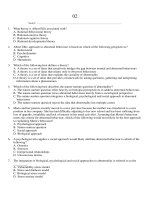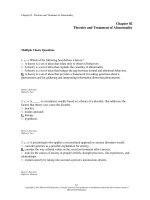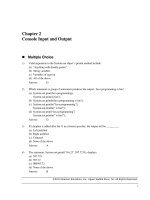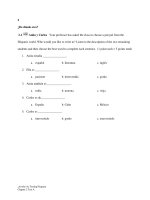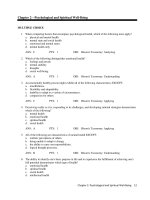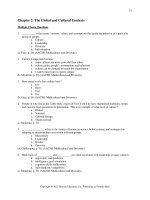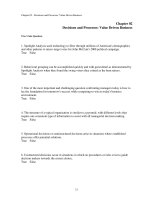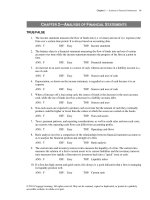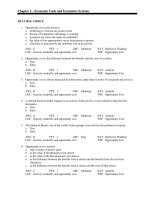MIS 3 3rd edition hossein bidgoli test bank
Bạn đang xem bản rút gọn của tài liệu. Xem và tải ngay bản đầy đủ của tài liệu tại đây (176.38 KB, 15 trang )
Chapter 2: Computers: The Machines Behind Computing
TRUE/FALSE
1. An object code must be translated into source code in order for the computer to be able to read and
execute.
ANS: F
PTS: 1
TOP: A-head: Defining a Computer
REF: 24
NAT: BUSPROG: Technology
KEY: Bloom's: Knowledge
2. The hardware components of a computer system consist of programs written in computer languages.
ANS: F
PTS: 1
TOP: A-head: Defining a Computer
REF: 24
NAT: BUSPROG: Technology
KEY: Bloom's: Knowledge
3. Both the ALU and the control unit are part of the BIOS.
ANS: F
PTS: 1
TOP: A-head: Defining a Computer
REF: 25
NAT: BUSPROG: Technology
KEY: Bloom's: Knowledge
4. A bus can be internal or external.
ANS: T
PTS: 1
TOP: A-head: Defining a Computer
REF: 25
NAT: BUSPROG: Technology
KEY: Bloom's: Knowledge
5. A computer with a 32-bit processor can perform calculations with larger numbers and be more
efficient with smaller numbers than a 64-bit system..
ANS: F
PTS: 1
TOP: A-head: Defining a Computer
REF: 25
NAT: BUSPROG: Technology
KEY: Bloom's: Knowledge
6. A serial port is a communication interface through which information is transferred one bit at a time.
ANS: T
PTS: 1
TOP: A-head: Defining a Computer
REF: 25
NAT: BUSPROG: Technology
KEY: Bloom's: Knowledge
7. Very-large-scale integration (VLSI) circuits were introduced in the fifth generation computers.
ANS: F
PTS: 1
REF: 26
NAT: BUSPROG: Technology
TOP: A-head: The History of Computer Hardware and Software
KEY: Bloom's: Knowledge
8. ENIAC is an example of a first-generation computer.
ANS: T
PTS: 1
REF: 26
NAT: BUSPROG: Technology
TOP: A-head: The History of Computer Hardware and Software
KEY: Bloom's: Knowledge
9. A byte is a single value of 0 or 1.
ANS: F
PTS: 1
REF: 28
NAT: BUSPROG: Technology
TOP: A-head: The Power of Computers
KEY: Bloom's: Knowledge
10. An Extended ASCII data code allows representation of 1024 characters.
ANS: T
PTS: 1
TOP: A-head:The Power of Computers
REF: 28
NAT: BUSPROG: Technology
KEY: Bloom's: Knowledge
11. A petabyte is 230 bytes.
ANS: F
PTS: 1
TOP: A-head: The Power of Computers
REF: 28
NAT: BUSPROG: Technology
KEY: Bloom's: Knowledge
12. Computers and communication systems use data codes to represent and transfer data between
computers and network systems.
ANS: T
PTS: 1
TOP: A-head: The Power of Computers
REF: 28
NAT: BUSPROG: Technology
KEY: Bloom's: Knowledge
13. The split keyboard has been developed for better ergonomics.
ANS: T
PTS: 1
REF: 29
TOP: A-head: Input, Output, and Memory Devices
NAT: BUSPROG: Technology
KEY: Bloom's: Knowledge
14. Light pen is an output device.
ANS: F
PTS: 1
REF: 29
TOP: A-head: Input, Output, and Memory Devices
NAT: BUSPROG: Technology
KEY: Bloom's: Knowledge
15. Trackballs are ideal for notebook computers because they occupy less space than a mouse.
ANS: T
PTS: 1
REF: 29
TOP: A-head: Input, Output, and Memory Devices
NAT: BUSPROG: Technology
KEY: Bloom's: Knowledge
16. A disadvantage of trackball is that positioning is sometimes less precise than with a mouse.
ANS: T
PTS: 1
REF: 29
TOP: A-head: Input, Output, and Memory Devices
NAT: BUSPROG: Technology
KEY: Bloom's: Knowledge
17. Inkjet printers produce characters by projecting electrically charged droplets of ink onto paper that
create an image.
ANS: T
PTS: 1
REF: 30
TOP: A-head: Input, Output, and Memory Devices
NAT: BUSPROG: Technology
KEY: Bloom's: Knowledge
18. Random access memory can be read from and written to.
ANS: T
PTS: 1
REF: 30
TOP: A-head: Input, Output, and Memory Devices
NAT: BUSPROG: Technology
KEY: Bloom's: Knowledge
19. A magnetic disk is a type of secondary memory device.
ANS: T
PTS: 1
REF: 31
TOP: A-head: Input, Output, and Memory Devices
NAT: BUSPROG: Technology
KEY: Bloom's: Knowledge
20. The contents of Programmable read-only memory (PROM) can be erased and reprogrammed.
ANS: F
PTS: 1
REF: 31
TOP: A-head: Input, Output, and Memory Devices
NAT: BUSPROG: Technology
KEY: Bloom's: Knowledge
21. A magnetic tape stores data sequentially.
ANS: T
PTS: 1
REF: 31
TOP: A-head: Input, Output, and Memory Devices
NAT: BUSPROG: Technology
KEY: Bloom's: Knowledge
22. A redundant array of independent disks (RAID) system is a collection of disk drives used for fault
tolerance and improved performance.
ANS: F
PTS: 1
REF: 32
TOP: A-head: Input, Output, and Memory Devices
NAT: BUSPROG: Technology
KEY: Bloom's: Knowledge
23. Flash memory is used in memory cards.
ANS: T
PTS: 1
REF: 32
TOP: A-head: Input, Output, and Memory Devices
NAT: BUSPROG: Technology
KEY: Bloom's: Knowledge
24. A SAN is a dedicated high-speed network consisting of both hardware and software used to connect
and manage shared storage devices, such as disk arrays, tape libraries, and optical storage devices.
ANS: T
PTS: 1
REF: 32
TOP: A-head: Input, Output, and Memory Devices
NAT: BUSPROG: Technology
KEY: Bloom's: Knowledge
25. NAS is composed of arrays such that if one disk in the array fails, data is not lost.
ANS: F
PTS: 1
REF: 33
TOP: A-head: Input, Output, and Memory Devices
NAT: BUSPROG: Technology
KEY: Bloom's: Knowledge
26. A NAS offers only storage; a SAN system offers both storage and file services.
ANS: T
PTS: 1
REF: 33
TOP: A-head: Input, Output, and Memory Devices
NAT: BUSPROG: Technology
KEY: Bloom's: Knowledge
27. NAS is popular for Web servers and e-mail servers because it lowers management costs and helps
make these servers more fault tolerant.
ANS: T
PTS: 1
REF: 33
TOP: A-head: Input, Output, and Memory Devices
NAT: BUSPROG: Technology
KEY: Bloom's: Knowledge
28. With NAS, as the number of users increase, the performance increases too.
ANS: F
PTS: 1
REF: 33
TOP: A-head: Input, Output, and Memory Devices
NAT: BUSPROG: Technology
KEY: Bloom's: Knowledge
29. Sometimes, 4GLs are called procedural languages.
ANS: F
PTS: 1
TOP: A-head: Computer languages
REF: 37
NAT: BUSPROG: Technology
KEY: Bloom's: Knowledge
30. C++ and Java are examples of high-level language
ANS: T
PTS: 1
TOP: A-head: Computer Languages
REF: 37
NAT: BUSPROG: Technology
KEY: Bloom's: Knowledge
MULTIPLE CHOICE
1. An advantage of silicon over gallium arsenide is that:
a. it’s less fragile than gallium arsenide.
c. it withstands higher temperatures than
gallium arsenide.
b. it survives much higher doses of radiation d. it emits light, whereas gallium arsenide
than gallium arsenide.
does not.
ANS: A
PTS: 1
REF: 26
NAT: BUSPROG: Technology
TOP: A-head: The History of Computer Hardware and Software
KEY: Bloom's: Knowledge
2. Transistor was the major technology used during the ____ generation of hardware.
a. first
c. third
b. second
d. fourth
ANS: B
PTS: 1
REF: 26
NAT: BUSPROG: Technology
TOP: A-head: The History of Computer Hardware and Software
KEY: Bloom's: Knowledge
3. IBM System z10 is an example of a ____ computer.
a. second-generation
c. fourth-generation
b. third-generation
d. fifth-generation
ANS: D
PTS: 1
REF: 26
NAT: BUSPROG: Technology
TOP: A-head: The History of Computer Hardware and Software
KEY: Bloom's: Knowledge
4. One of the major disadvantages of silicon is that:
a. mass production of silicon devices is
c. it is very soft and fragile.
difficult.
b. it cannot emit light.
d. it is very costly.
ANS: B
PTS: 1
REF: 26
NAT: BUSPROG: Technology
TOP: A-head: The History of Computer Hardware and Software
KEY: Bloom's: Knowledge
5.
____ is 1/1,000,000,000,000 of a second.
a. Millisecond
b. Microsecond
ANS: D
PTS: 1
TOP: A-head: The Power of Computers
c. Nanosecond
d. Picosecond
REF: 27
NAT: BUSPROG: Technology
KEY: Bloom's: Knowledge
6. ____ means saving data in computer memory and retrieval is accessing data from memory.
a. Encapsulation
c. Assembling
b. Replication
d. Storage
ANS: D
PTS: 1
TOP: A-head: The Power of Computers
REF: 27
NAT: BUSPROG: Technology
KEY: Bloom's: Knowledge
7. How many bytes is a data of 48 bits?
a. 6
b. 24
ANS: B
PTS: 1
TOP: A-head: The Power of Computers
c. 64
d. 384
REF: 28
NAT: BUSPROG: Technology
KEY: Bloom's: Application
8. Extended ASCII data code allows representation of:
a. 64 characters.
c. 256 characters.
b. 129 characters.
d. 1024 characters.
ANS: C
PTS: 1
TOP: A-head: The Power of Computers
9. A ____ is the size of a character.
a. nibble
b. bit
ANS: C
PTS: 1
TOP: A-head: The Power of Computers
REF: 28
NAT: BUSPROG: Technology
KEY: Bloom's: Knowledge
c. byte
d. word
REF: 28
NAT: BUSPROG: Technology
KEY: Bloom's: Knowledge
10. In a(n) ____ file, each alphabetic, numeric, or special character is represented with a 7-bit binary
number.
a. EBCDIC
c. ASCII
b. Unicode
d. extended ASCII
ANS: C
PTS: 1
TOP: A-head: The Power of Computers
11. ASCII defines up to ____ characters.
a. 8
b. 128
ANS: B
PTS: 1
TOP: A-head: The Power of Computers
REF: 28
NAT: BUSPROG: Technology
KEY: Bloom's: Knowledge
c. 258
d. 1024
REF: 28
NAT: BUSPROG: Technology
KEY: Bloom's: Knowledge
12. Computers and communication systems use _____ to represent and transfer information between
computers and network systems.
a. Optical character reader (OCR)
c. data codes
b. light pens
d. Magnetic ink character recognition
(MICR)
ANS: C
PTS: 1
TOP: A-head: The Power of Computers
13. Which of the following is an input device?
a. Optical character reader
b. Plotter
REF: 28
NAT: BUSPROG: Technology
KEY: Bloom's: Knowledge
c. Display monitor
d. Printer
ANS: A
PTS: 1
REF: 29
TOP: A-head: Input, Output, and Memory Devices
NAT: BUSPROG: Technology
KEY: Bloom's: Knowledge
14. _____ works on the same principle as a barcode reader but reads text instead of barcodes.
a. Optical character reader (OCR)
c. Light pen
b. Magnetic ink character recognition
d. Touch screen
(MICR) system
ANS: A
PTS: 1
REF: 29
TOP: A-head: Input, Output, and Memory Devices
NAT: BUSPROG: Technology
KEY: Bloom's: Knowledge
15. _____ is the most common output device for soft copy.
a. Liquid crystal display
c. Laser printer
b. Inkjet printer
d. Voice synthesis device
ANS: A
PTS: 1
REF: 30
TOP: A-head: Input, Output, and Memory Devices
16. The Clipboard’s contents are stored on ____.
a. ROM
b. RAM
NAT: BUSPROG: Technology
KEY: Bloom's: Knowledge
c. PROM
d. EPROM
ANS: B
PTS: 1
REF: 30
TOP: A-head: Input, Output, and Memory Devices
NAT: BUSPROG: Technology
KEY: Bloom's: Knowledge
17. ____ memory, which is nonvolatile, holds data when the computer is off or during the course of a
program’s operation.
a. Raw
c. Secondary
b. Open
d. Replicated
ANS: C
PTS: 1
REF: 30
TOP: A-head: Input, Output, and Memory Devices
18. ROM is different from RAM in that:
a. it is volatile.
b. it is a secondary memory.
NAT: BUSPROG: Technology
KEY: Bloom's: Knowledge
c. it is nonvolatile.
d. data can only be written to it, not read.
ANS: C
PTS: 1
REF: 31
TOP: A-head: Input, Output, and Memory Devices
NAT: BUSPROG: Technology
KEY: Bloom's: Knowledge
19. A(n) ____ is a type of memory that stores data sequentially.
a. RAM
c. optical disk
b. magnetic tape
d. RAID
ANS: B
PTS: 1
REF: 31
TOP: A-head: Input, Output, and Memory Devices
20. A common type of _____ is WORM disc.
a. Magnetic storage
b. Optical storage
NAT: BUSPROG: Technology
KEY: Bloom's: Knowledge
c. RAM
d. ROM
ANS: B
PTS: 1
REF: 31
TOP: A-head: Input, Output, and Memory Devices
NAT: BUSPROG: Technology
KEY: Bloom's: Knowledge
21. CD-ROMs and DVDs are examples of _____.
a. magnetic tapes
c. optical discs
b. RAM
d. main memory
ANS: C
PTS: 1
REF: 31
TOP: A-head: Input, Output, and Memory Devices
22. The term RAID stands for ____.
NAT: BUSPROG: Technology
KEY: Bloom's: Knowledge
a.
b.
c.
d.
random access for independent disks
redundant access for independent devices
random array of independent drives
redundant array of independent disks
ANS: D
PTS: 1
REF: 32
TOP: A-head: Input, Output, and Memory Devices
NAT: BUSPROG: Technology
KEY: Bloom's: Knowledge
23. Typically, ____ are used only in large enterprises because of their cost and installation complexity.
a. SANs
c. CD-ROMs
b. NASs
d. hard disks
ANS: A
PTS: 1
REF: 32
TOP: A-head: Input, Output, and Memory Devices
NAT: BUSPROG: Technology
KEY: Bloom's: Knowledge
24. _____ allow off-site users to connect to network resources, such as network file storage, printers, and
databases.
a. Remote access servers (RAS)
c. Application servers
b. Web servers
d. Disk servers
ANS: D
PTS: 1
TOP: A-head: Classes of Computers
25. An example of a(n) _____ is UNIX.
a. SAN
b. RAID
ANS: D
PTS: 1
TOP: A-head: What Is Software?
REF: 34
NAT: BUSPROG: Technology
KEY: Bloom's: Knowledge
c. server
d. operating system
REF: 35
NAT: BUSPROG: Technology
KEY: Bloom's: Knowledge
26. _____ is a function performed by control programs that manages computer resources, such as storage
and memory.
a.
b.
Job management
Resource allocation
ANS: B
PTS: 1
TOP: A-head: What Is Software?
27.
c.
d.
Data management
Communication
REF: 35
NAT: BUSPROG: Technology
KEY: Bloom's: Knowledge
_____ is a function performed by control programs that controls data integrity by generating
checksums to verify that data has not been corrupted or changed.
a.
c. Data management
Job management
b.
d.
Communication
Resource allocation
ANS: C
PTS: 1
TOP: A-head: What Is Software?
REF: 35
NAT: BUSPROG: Technology
KEY: Bloom's: Knowledge
28. _____ is a function performed by control programs that controls the transfer of data among parts of a
computer system, such as exchange of information between the CPU and I/O devices.
a. Job management
c. Data management
b. Resource allocation
d. Communication
ANS: D
PTS: 1
TOP: A-head: What Is Software?
REF: 35
NAT: BUSPROG: Technology
KEY: Bloom's: Knowledge
29. The control programs managing computer hardware and software perform the ____ function to control
and prioritize tasks performed by the CPU.
a. application management
c. data management
b. resource allocation
d. job management
ANS: D
PTS: 1
TOP: A-head: What Is Software?
REF: 35
NAT: BUSPROG: Technology
KEY: Bloom's: Knowledge
30. The supervisor program of an OS is called the ____.
a. kernel
c. job manager
b. resource allocator
d. data manager
ANS: A
PTS: 1
TOP: A-head: What Is Software?
REF: 35
NAT: BUSPROG: Technology
KEY: Bloom's: Knowledge
31. ____ OSs allow several users to use computer resources simultaneously.
a. Kernel
c. Hierarchical
b. Web-driven
d. Time-shared
ANS: D
PTS: 1
TOP: A-head: What Is Software?
REF: 35
NAT: BUSPROG: Technology
KEY: Bloom's: Knowledge
32. An operating system (OS) is:
a. a set of programs for controlling and
c. is a collection of disk drives used for fault
managing computer hardware and
tolerance, typically in large network
software.
systems.
b. a computer and all the software for
d. the main circuit board containing
managing network resources and offering
connectors for attaching additional boards.
services to a network.
ANS: A
PTS: 1
TOP: A-head: What Is Software?
REF: 35
NAT: BUSPROG: Technology
KEY: Bloom's: Knowledge
33. Which of the following computer languages is the easiest to use?
a. Assembly language
c. Fourth-generation language
b. First-generation language
d. Machine language
ANS: C
PTS: 1
TOP: A-head: Computer Languages
REF: 35
NAT: BUSPROG: Technology
KEY: Bloom's: Knowledge
34. _____ computer languages are machine independent and are called high-level languages.
a. First-generation
b. Second-generation
ANS: C
PTS: 1
TOP: A-head: Computer Languages
35. Java and C++ are ____ languages.
a. assembly
b. high-level
ANS: B
PTS: 1
TOP: A-head: Computer Languages
c. Third-generation
d. Fourth-generation
REF: 37
NAT: BUSPROG: Technology
KEY: Bloom's: Knowledge
c. machine
d. second-generation computer
REF: 37
NAT: BUSPROG: Technology
KEY: Bloom's: Knowledge
COMPLETION
1. The ____________________ is the heart of a computer.
ANS: central processing unit (CPU)
PTS: 1
REF: 25
TOP: A-head: Defining a Computer
NAT: BUSPROG: Technology
KEY: Bloom's: Knowledge
2. The ____________________ tells the computer what to do, such as instructing the computer which
device to read or send output to.
ANS: control unit
PTS: 1
REF: 25
TOP: A-head: Defining a Computer
NAT: BUSPROG: Technology
KEY: Bloom's: Knowledge
3. ____________________ bits equal 1 byte.
ANS: 8
PTS: 1
REF: 28
TOP: A-head: Defining a Computer
4.
NAT: BUSPROG: Technology
KEY: Bloom's: Knowledge
____________________ is a light-sensitive stylus connected to the monitor with a cable. When it is
placed on an on-screen location, the data in that spot is sent to the computer.
ANS: Light pen
PTS: 1
REF: 29
NAT: BUSPROG: Technology
TOP: A-head: Input, Output, and Memory Devices
KEY: Bloom's: Knowledge
5. The most common type of main memory is a semiconductor memory chip made of
____________________.
ANS: silicon
PTS: 1
REF: 30
NAT: BUSPROG: Technology
TOP: A-head: Input, Output, and Memory Devices
KEY: Bloom's: Knowledge
6. ____________________ read-only memory is similar to PROM, but its contents can be erased and
reprogrammed.
ANS: Erasable programmable
PTS: 1
REF: 31
NAT: BUSPROG: Technology
TOP: A-head: Input, Output, and Memory Devices
KEY: Bloom's: Knowledge
7. A(n) ____________________ disk made of Mylar or metal is used for random-access processing.
ANS: magnetic
PTS: 1
REF: 31
NAT: BUSPROG: Technology
TOP: A-head: Input, Output, and Memory Devices
KEY: Bloom's: Knowledge
8. ____________________ discs use laser beams to access and store data.
ANS: Optical
PTS: 1
REF: 31
NAT: BUSPROG: Technology
TOP: A-head: Input, Output, and Memory Devices
KEY: Bloom's: Knowledge
9. A SAN offers only storage; a(n) ____________________ system offers both storage and file services.
ANS:
network attached storage (NAS)
network attached storage
NAS
PTS: 1
REF: 33
NAT: BUSPROG: Technology
TOP: A-head: Input, Output, and Memory Devices
KEY: Bloom's: Knowledge
10. ____________________ computers are usually compatible with the IBM System/360 line introduced
in 1965.
ANS: Mainframe
PTS: 1
REF: 33
TOP: A-head: Classes of Computers
NAT: BUSPROG: Technology
KEY: Bloom's: Knowledge
11. ____________________ servers store Web pages for access over the Internet.
ANS: Web
PTS: 1
REF: 34
TOP: A-head: Classes of Computers
NAT: BUSPROG: Technology
KEY: Bloom's: Knowledge
12. The ____________________ function of an operating system manages computer resources, such as
storage and memory.
ANS: resource allocation
PTS: 1
REF: 35
TOP: A-head: What Is Software?
NAT: BUSPROG: Technology
KEY: Bloom's: Knowledge
13. Microsoft PowerPoint is the most commonly used ____________________ software.
ANS: presentation
PTS: 1
REF: 36
TOP: A-head: What Is Software?
NAT: BUSPROG: Technology
KEY: Bloom's: Knowledge
14. ____________________ software is used for drafting and design and has replaced traditional tools,
such as T-squares, triangles, paper, and pencils.
ANS:
Computer-aided design (CAD)
Computer-aided design
CAD
PTS: 1
REF: 37
TOP: A-head: What Is Software?
NAT: BUSPROG: Technology
KEY: Bloom's: Knowledge
15. Imagine that you could ask your computer, “What product generated the most sales last year?”and the
computer responds with a correct answer. ____________________ facilitate such natural
conversations.
ANS: NLP
PTS: 1
REF: 38
TOP: A-head: Computer Languages
NAT: BUSPROG: Technology
KEY: Bloom's: Application
SHORT ANSWER
1. Provide a general description of how to write a computer program.
ANS:
To write a computer program, first you must know what needs to be done, and then you must plan a
method to achieve this goal, including selecting the right language for the task. Many computer
languages are available; the language you select depends on the problem being solved and the type of
computer you’re using. Regardless of the language, a program is also referred to as the “source code.”
This source code must be translated into object code consisting of binary 0s and 1s.
PTS: 1
REF: 24
TOP: A-head: Defining a Computer
NAT: BUSPROG: Technology
KEY: Bloom's: Knowledge
2. What is a bus?
ANS:
A bus is a link between devices connected to the computer. It can be parallel or serial, internal (local)
or external.
PTS: 1
REF: 25
TOP: A-head: Defining a Computer
NAT: BUSPROG: Technology
KEY: Bloom's: Knowledge
3. Write a short note on single processor and multiprocessor systems.
ANS:
Some computers have a single processor; other computers, called "multiprocessors," contain multiple
processors. Multiprocessing is the use of two or more CPUs in a single computer system. Generally, a
multiprocessor computer has better performance than a single-processor computer in the same way
that a team would have better performance than an individual on a large, time-consuming project.
PTS: 1
REF: 25
TOP: A-head: Defining a Computer
4. What is a motherboard?
ANS:
NAT: BUSPROG: Technology
KEY: Bloom's: Knowledge
A motherboard is the main circuit board containing connectors for attaching additional boards. In
addition, it usually contains the CPU, Basic Input/Output System (BIOS), memory, storage, interfaces,
serial and parallel ports, expansion slots, and all the controllers for standard peripheral devices, such as
the display monitor, disk drive, and keyboard.
PTS: 1
REF: 25
TOP: A-head: Defining a Computer
NAT: BUSPROG: Technology
KEY: Bloom's: Knowledge
5. Write a note on computer speed. On what basis is the speed determined?
ANS:
Typically, computer speed is measured as the number of instructions performed during the following
fractions of a second:
• Millisecond: 1/1000 of a second
• Microsecond: 1/1,000,000 of a second
• Nanosecond: 1/1,000,000,000 of a second
• Picosecond: 1/1,000,000,000,000 of a second
PTS: 1
REF: 27
TOP: A-head: The Power of Computers
NAT: BUSPROG: Technology
KEY: Bloom's: Knowledge
6. What is a binary system?
ANS:
A binary system consists of 0s and 1s, with a 1 representing “on” and a 0 representing “off,” similar to
a light switch.
PTS: 1
REF: 28
TOP: A-head: The Power of Computers
NAT: BUSPROG: Technology
KEY: Bloom's: Knowledge
7. Write a note on touch screens.
ANS:
Touch screens, which usually work with menus, are actually a combination of input devices. Some
touch screens rely on light detection to determine which menu item has been selected, and others are
pressure sensitive. Touch screens are often easier to use than keyboards, but they might not be as
accurate because selections can be misread. You probably saw touch screens used extensively during
the 2012 presidential election to quickly show electoral maps and analyze election data in different
ways.
PTS: 1
REF: 29
NAT: BUSPROG: Technology
TOP: A-head: Input, Output, and Memory Devices
KEY: Bloom's: Knowledge
8. What are the most common output devices for soft copy?
ANS:
The most common output devices for soft copy are cathode ray tube (CRT), plasma display, and liquid
crystal display (LCD).
PTS: 1
REF: 30
NAT: BUSPROG: Technology
TOP: A-head: Input, Output, and Memory Devices
KEY: Bloom's: Knowledge
9. What are the main types of secondary memory?
ANS:
There are three main types: magnetic disks, magnetic tape, and optical discs.
PTS: 1
REF: 31
NAT: BUSPROG: Technology
TOP: A-head: Input, Output, and Memory Devices
KEY: Bloom's: Knowledge
10. What is the reason for the popularity of memory sticks?
ANS:
Memory sticks have become popular because of their small size, high storage capacity, and decreasing
cost.
PTS: 1
REF: 32
NAT: BUSPROG: Technology
TOP: A-head: Input, Output, and Memory Devices
KEY: Bloom's: Knowledge
11. Explain how RAID provides fault tolerance and improved performance.
ANS:
With RAID, data can be stored in multiple places to improve the system’s reliability. In other words, if
one disk in the array fails, data isn’t lost. In some RAID configurations, sequences of data can be read
from multiple disks simultaneously, which improves performance.
PTS: 1
REF: 32
NAT: BUSPROG: Technology
TOP: A-head: Input, Output, and Memory Devices
KEY: Bloom's: Knowledge
12. What is a fax server?
ANS:
Fax servers contain software and hardware components that enable users to send and receive faxes.
PTS: 1
REF: 34
TOP: A-head: Classes of Computers
NAT: BUSPROG: Technology
KEY: Bloom's: Knowledge
13. What is a print server?
ANS:
Print servers enable users to send print jobs to network printers.
PTS: 1
REF: 34
TOP: A-head: Classes of Computers
NAT: BUSPROG: Technology
KEY: Bloom's: Knowledge
14. Write a note on desktop publishing software.
ANS:
Desktop publishing software is used to produce professional-quality documents without expensive
hardware and software. This software works on a “what-you-see-is-what-you-get” (WYSIWYG,
pronounced “wizzy-wig”) concept, so the high-quality screen display gives you a good idea of what
you’ll see in the printed output.
PTS: 1
REF: 36
TOP: A-head: What Is Software?
15. What is an assembly language?
NAT: BUSPROG: Technology
KEY: Bloom's: Knowledge
ANS:
Assembly language is the second generation of computer languages. It is a higher-level language than
machine language but is also machine dependent. It uses a series of short codes, or mnemonics, to
represent data or instructions.
PTS: 1
REF: 37
TOP: A-head: Computer Languages
NAT: BUSPROG: Technology
KEY: Bloom's: Knowledge
ESSAY
1. Provide a definition for a computer and explain the purpose of a computer program.
ANS:
A computer is defined as a machine that accepts data as input, processes data without human
intervention by using stored instructions, and outputs information. The instructions, also called a
“program,” are step-by-step directions for performing a specific task, written in a language the
computer can understand. Remember that a computer only processes data (raw facts); it can’t change
or correct the data that’s entered. If data is erroneous, the information the computer provides is also
erroneous. This rule is sometimes called GIGO: garbage in, garbage out.
PTS: 1
REF: 24
TOP: A-head: Defining a Computer
NAT: BUSPROG: Technology
KEY: Bloom's: Knowledge
2. Describe the use of gallium arsenide as a replacement for silicon.
ANS:
As silicon can’t emit light and has speed limitations, computer designers have concentrated on
technology using gallium arsenide, in which electrons move almost five times faster than in silicon.
Devices made with this synthetic compound can emit light, withstand higher temperatures, and survive
much higher doses of radiation than silicon devices. The major problems with gallium arsenide are
difficulties in mass production. This material is softer and more fragile than silicon, so it breaks more
easily during slicing and polishing. Because of the high costs and difficulty of production, the military
is currently the major user of this technology. However, research continues to eliminate some
shortcomings of this technology.
PTS: 1
REF: 26
NAT: BUSPROG: Technology
TOP: A-head: The History of Computer Hardware and Software
KEY: Bloom's: Knowledge
3. What is the most common type of main memory? Describe the purpose of cache RAM.
ANS:
The most common type of main memory is a semiconductor memory chip made of silicon. A
semiconductor memory device can be volatile or nonvolatile. Volatile memory is called random access
memory (RAM), although you could think of it as “read-write memory.” In other words, data can be
read from and written to RAM. Some examples of the type of information stored in RAM include open
files, the Clipboard’s contents, running programs, and so forth. A special type of RAM, called cache
RAM, resides on the processor. Because memory access from main RAM storage generally takes
several clock cycles (a few nanoseconds), cache RAM stores recently accessed memory so the
processor isn’t waiting for the memory transfer.
PTS: 1
REF: 30-31
NAT: BUSPROG: Technology
TOP: A-head: Input, Output, and Memory Devices
KEY: Bloom's: Knowledge
4. Describe the data management function of an operating system.
ANS:
This function controls data integrity by generating checksums to verify that data hasn’t been corrupted
or changed. Briefly, when the OS writes data to storage, it generates a value (the checksum) along with
the data. The next time this data is retrieved, the checksum is recalculated and compared with the
original checksum. If they match, the integrity is intact. If they don’t, the data has been corrupted
somehow.
PTS: 1
REF: 35
TOP: A-head: What Is Software?
NAT: BUSPROG: Technology
KEY: Bloom's: Knowledge
5. Write a short note on fifth-generation languages and briefly describe some of its features.
ANS:
Fifth-generation languages (5GLs) use some of the artificial intelligent technologies, such as
knowledge-based systems, natural language processing (NLP), visual programming, and graphical
approach to using programming. Codes are automatically generated and designed to make the
computer solve a given problem without a programmer or with minimum programming efforts. These
languages are designed to facilitate natural conversations between you and the computer. Imagine that
you could ask your computer, “What product generated the most sales last year?” Your computer,
equipped with a voice synthesizer, could respond, “Product X.” Dragon NaturallySpeaking Solutions
is an example of NLP. Research continues in this field because of the promising results so far.
PTS: 1
REF: 38
TOP: A-head: Computer Languages
NAT: BUSPROG: Technology
KEY: Bloom's: Knowledge
